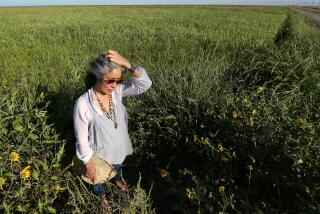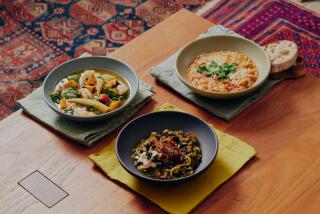The American Grain
Wild rice is really not rice, nor is it as wild as it once was. So, how did it get its name?
One theory is that when the 17th-Century French explorers first encountered the grain in North America, they called it folle avoine , âcrazy oats.â It is speculated that this later became wild rice because of the similarity of the grain to common rice.
Wild rice is self-propagating in the lakes and rivers in the Northern Great Lakes region and is the only grain native to North America. Today, most of the wild rice found in the markets is cultivated in man-made paddies in Minnesota and California.
Still, throughout Minnesota and into Canada, original natural stands of wild rice continue to flourish. For Native American tribes of these regions, wild rice was once an important source of protein. Today, it is a necessary part of preserving the culture and heritage of the tribes.
It has been difficult to maintain the tradition of hand-harvested wild rice. But Dave Reinke, the manager of Manitok Wild Rice, a Native American-owned company in Callaway, Minn. that sells hand-harvested wild rice, reports: âOur 1994 harvest has been excellent in both quality and quantity.â
In and around the area of Callaway, the Ojibwa, also known as the Chippewa, gathered the rice as they guided their bark canoes between the rice stands, bending the stalks of rice with one short stick and threshing it with a second stick, causing the ripe grains to shower the bottom of the canoe. Today, the wild rice sold by Manitok is still gathered as it was long ago.
Rinse wild rice with cold water and drain well before cooking. To cook the rice, use three cups of liquid to one cup of rice. The full, nutty flavor of wild rice makes it possible to omit the salt without losing any flavor. It is wasteful to cook wild rice in enormous amounts of water and then throw away the excess since it is an extremely nutritious grain (much more so than common rice).
*
Wild rice is cooked when most of the grains are cracked or opened, revealing the fluffy white interior, and the texture (taste it!) is just slightly chewy. Depending on the way the rice has been cured, this can take anywhere from 25 to 50 minutes, so it is best to let your eye and taste be the final judge. If there is cooking water left in the pan, it will be absorbed by the rice when it stands, tightly covered, for 10 minutes before serving. Or, once the rice is done, uncover the pan and boil gently over medium heat until the water left in the bottom of the pan evaporates. One cup raw wild rice will yield 3 1/2 to 4 cups cooked rice, depending on the quality of the rice.
*
With a big green salad, a piece of cheese, warm, crusty, whole-wheat rolls and a light dessert such as maple-flavored applesauce, the following soup makes a delicious supper on a chilly day. It can be prepared a day or two in advance and reheated just before serving.
BUTTERNUT SQUASH, APPLE AND WILD RICE SOUP
1 to 2 butternut or acorn squash, quartered and seeded
Unsalted butter
1/2 cup chopped onion
1 peeled, cored and diced tart apple, such as Granny Smith
1 tablespoon peeled and minced ginger root
2 cups filtered unsweetened apple juice
1 1/2 cups cooked wild rice
1 1/2 to 2 cups milk or half and half
Salt
1/8 teaspoon freshly ground black pepper
1 (15-ounce) can unsalted or reduced-sodium chicken broth, optional
1/2 cup chopped unblanched almonds, hazelnuts or walnuts
Dash ground cinnamon
1 tablespoon finely chopped parsley
To prepare soup, steam squash on vegetable steaming rack set over 1 inch gently boiling water in large, broad, covered saucepan until very tender, about 20 minutes. Cool slightly. Scoop softened squash flesh from skins with tablespoon and set aside. Discard skins.
Meanwhile melt 1 tablespoon butter in saucepan. Add onion and apple. Saute, stirring, until very tender, about 5 minutes. Stir in ginger root and saute 1 minute. Add apple juice and steamed squash and bring to boil. Cover and cook over low heat 10 minutes. Uncover and cool slightly.
Puree liquids and solids together, in batches if necessary, in blender or food processor until smooth. Return soup to saucepan. Soup can be prepared up to 1 day or several hours ahead to this point. Add wild rice, 1 1/2 cups milk, 1 teaspoon salt (or to taste) and pepper. Add additional milk or broth to thin to desired consistency. (Thickness of soup will vary with amount of moisture in squash.) Reheat over low heat until steaming, but do not boil. Correct seasoning.
To prepare garnish, melt 1 teaspoon butter in small skillet. Add nuts and saute until golden. Season to taste lightly with salt and cinnamon. Stir in parsley. Remove from heat.
At serving time, ladle hot soup into bowls. Top each with 1 spoonful nut mixture. Makes 4 servings.
APPLESAUCE WITH MAPLE SYRUP
1 (16-ounce) jar unsweetened applesauce
2 tablespoons pure maple syrup, or more to taste
Heat applesauce in small saucepan until warm, about 5 minutes. Stir in maple syrup until blended.
Applesauce may be served warm, at room temperature or cold from refrigerator. Makes 4 servings.
More to Read
Eat your way across L.A.
Get our weekly Tasting Notes newsletter for reviews, news and more.
You may occasionally receive promotional content from the Los Angeles Times.









